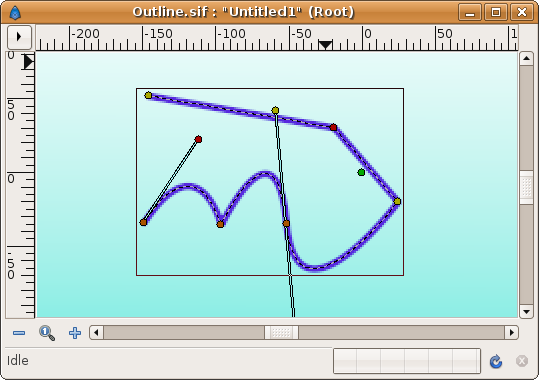Outline Layer
(Created page with "<!-- Page info --> {{Title|Outline Layer}} {{Category|Layers}} <!-- Page info end --> {{l|Image:Layer_geometry_outline_icon.png|64px}} == Despre straturile pentru contur== Str...") |
(→Parametrii straturilor pentru contur) |
||
| Line 14: | Line 14: | ||
==Parametrii straturilor pentru contur== | ==Parametrii straturilor pentru contur== | ||
| − | Parametrii straturilor pentru contur sunt: | + | Parametrii straturilor pentru contur sunt (am lasat denumirile in engleza): |
{|border="0" align="left" style="border-collapse" cellpadding="3" cellspacing="0" | {|border="0" align="left" style="border-collapse" cellpadding="3" cellspacing="0" | ||
|-style="background:#silver" | |-style="background:#silver" | ||
| − | |''' | + | |'''Nume'''||'''Valoare'''||'''Tip''' |
|- | |- | ||
||{{l|Image:Type_real_icon.png|16px}} {{l|Z Depth Parameter|Z Depth}} | ||{{l|Image:Type_real_icon.png|16px}} {{l|Z Depth Parameter|Z Depth}} | ||
| Line 131: | Line 131: | ||
|} | |} | ||
| − | |||
| − | |||
| − | |||
| − | |||
| − | |||
| − | |||
| − | |||
| − | |||
| − | |||
| − | |||
| − | |||
| − | |||
| − | |||
| − | |||
| − | |||
| − | |||
| − | |||
| − | |||
| − | |||
| − | |||
| − | |||
| − | |||
| − | |||
| − | |||
| − | |||
| − | |||
| − | |||
| − | |||
| − | |||
| − | |||
| − | |||
| − | |||
| − | |||
| − | |||
| − | |||
| − | |||
| − | |||
== Specific parameters for Outline Layers == | == Specific parameters for Outline Layers == | ||
Revision as of 08:41, 29 March 2012
|
Warning! This page contains outdated information. The release of Synfig Studio 0.64.0 introduced new terminology and this translated page needs to be updated according to original English text. You can help updating this page - see instructions here. Thank you! |
Contents
Despre straturile pentru contur
Straturile pentru contur (Outline Layers) sunt folosite pentru a stoca formele create cu instrumentul pensula sau contururile formelor. Acestea dau un aspect de desen animat. Contururile separate (strokes) sunt folosite pentru a defini cute sau desene 3D si sunt sunt adaugate umbrelor (create folosind trecerea de culoare - gradient sau proprietatea feather), constituind baza pentru o lucrare a unui artist.
Pentru a crea un strat pentru contur (Outline Layer) folositi BLine Tool/ro si bifati Create Outline BLine din caseta Tool Options Panel. Dupa ce ati terminat definirea geometriei conturului si dupa ce ati apasat butonul Execute (sau ati selectat alt instrument sau stare) este creat stratul pentru contur, avand culoarea din prim-plan (foreground).
Parametrii straturilor pentru contur
Parametrii straturilor pentru contur sunt (am lasat denumirile in engleza):
| Nume | Valoare | Tip |
| 0.000000 | real | |
| 1.000000 | real | |
| Composite | integer | |
|
|
color | |
| 0.000000u,0.000000u | vector | |
|
|
bool | |
|
|
bool | |
| 0.000000pt | real | |
| Fast Gaussian Blur | integer | |
| Non Zero | integer | |
| List | list (BLine) | |
| 2.000000pt | real | |
| 0.000000pt | real | |
|
|
bool | |
|
|
bool | |
|
|
bool | |
| 1.000000 | real | |
|
|
bool |
Specific parameters for Outline Layers
The first 11 parameters of the Outline are common parameter that are shared for several types of Layers. Click on the links to see their definitions. Only the particular parameters for the Outline Layer are described here.
This is a sample screen shot of an Outline Layer in action:
Outline width
The Outline width parameter is a float value in pixels that represents the basic value of the width for all the points of the curve at the same time. It works together with the width parameter of the vertices' child values. So setting the Outline Width to 1.0px then the resulting value for the rendered width in that vertex comes from this formula: W = OLW * VW + 2E.
Where:
- W = resulting width of the outline at that vertex.
- OLW = overall parameter for the width of all the vertices (that is the Outline Width parameter).
- VW = specific vertex width value.
- E = value of the Expand parameter.
The width duck would show the radius value for that vertex (W/2).
The width that ends up being used for each vertex is ((VertexWidth * OutLineWidth) + Expand*2):
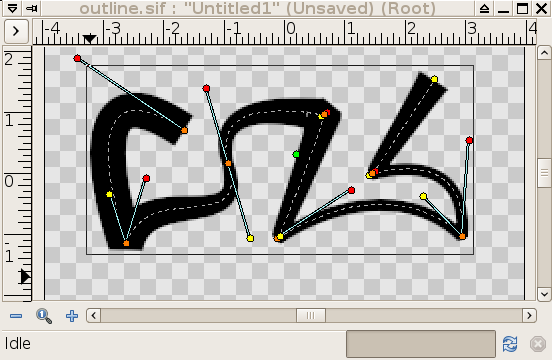
|
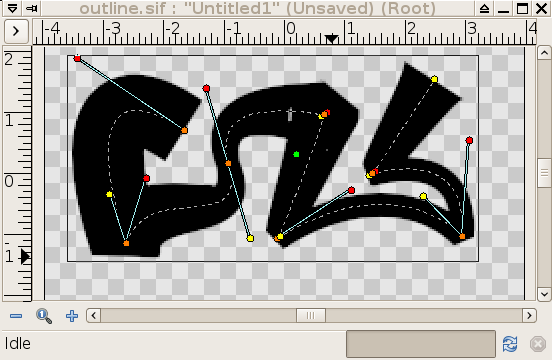
|
| starting image | after doubling the value of 'outline width' |
It's possible to specify negative values for the width values, which kind of turns the vertex inside out. Here's an example where the left vertex has a negative width and the right has a positive width. Note how the edges of the bline between the vertices cross each other in the middle:
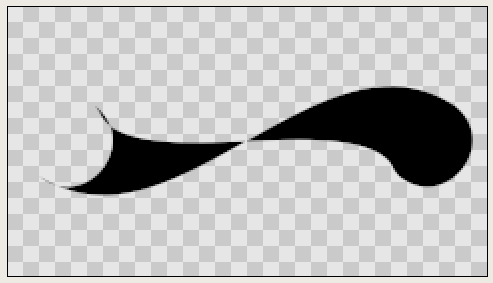
|
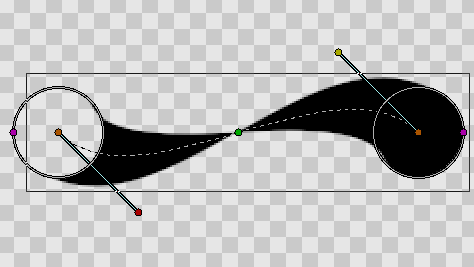
|
Expand
The Expand parameter is similar to the Outline Width parameter, but rather than being multiplied by each vertex's width, it is added to the radius of each vertex. In other words (2*Expand) is added to the diameter of each vertex.
The width that ends up being used for each vertex is ((VertexWidth * OutLineWidth) + Expand*2):

|
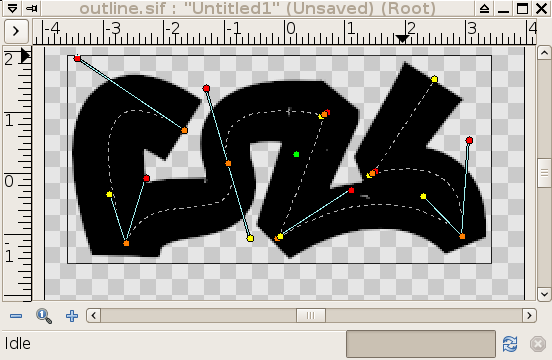
|
| zero 'expand' | non-zero 'expand' |
Sharp cups
Enabling 'sharp cusps' makes the corners pointy when the tangents are split:

|
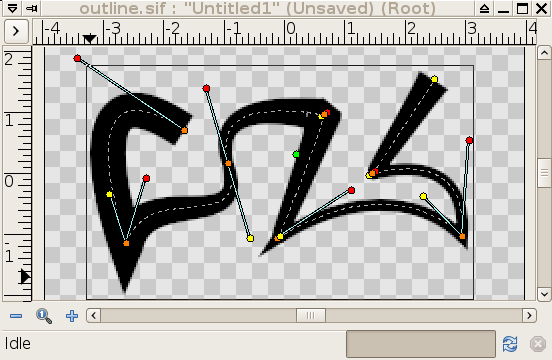
|
| no sharp cusps | sharp cusps |
Rounded Begin
Enabling 'rounded begin' makes the start of the outline rounded:

|
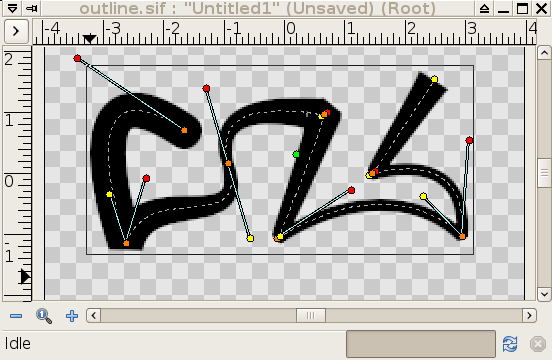
|
| no rounded begin | rounded begin |
Rounded End
Enabling 'rounded end' makes the end of the outline rounded:

|
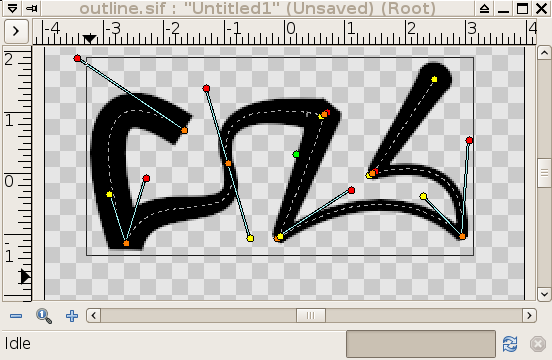
|
| no rounded end | rounded end |
Loopyness
This parameter currently does absolutely nothing at all!
Homogeneous
Enabling 'Homogeneous' changes the way that the width of the outline changes from one blinepoint to the next. Each point in the bline has its own width, and the bline has its own 'Outline Width' and 'Expand' parameters which are used to give the final width at each blinepoint. The 'Homogeneous' parameter controls how the width is interpolated between two neighbouring blinepoints:
- When 'Homogeneous' isn't checked, the width is interpolated linearly with the spline's 't' parameter.
- When 'Homogeneous' is checked, the width is interpolated linearly with the spline's length.
Turning off homogeneous often makes the fat end of a bline look lumpy. Maybe that's a bug:
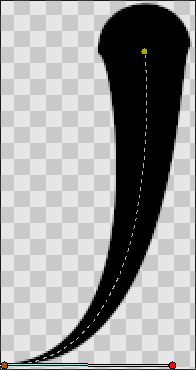
|
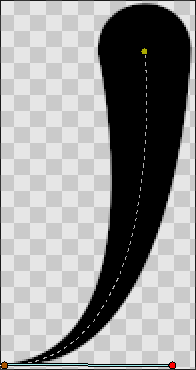
|
| not homogeneous | homogeneous |
Misc
The 'antialias' checkbox isn't specific to the Outline layer, but it is particularly useful for the Outline layer. It makes the edges appear smoother:
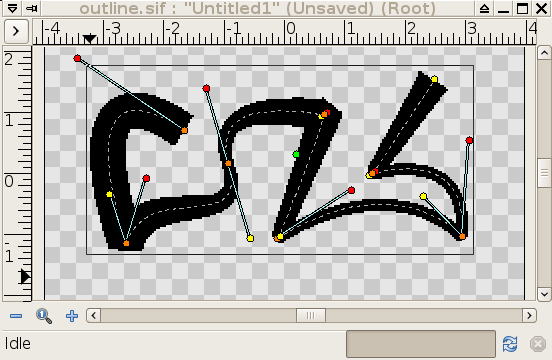
|

|
| not antialiased | antialiased |
